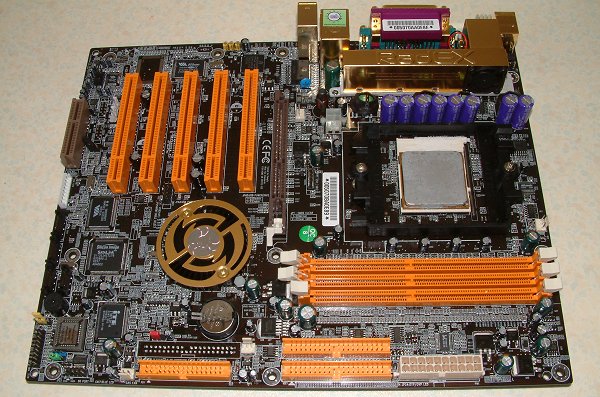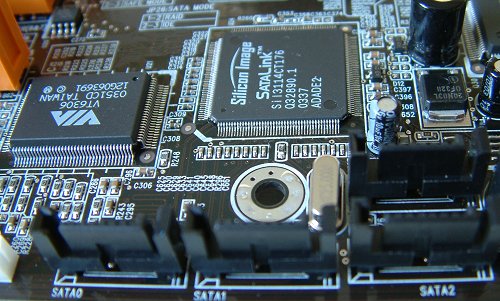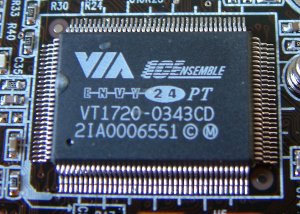Layout and features
One of the nForce3 250(Gb)'s main advances has been greater feature integration right on the single-chip design. On-chip SATA, Gigabit Ethernet via a compliant PHY, hardware firewall for the Gb variant, and extra USB2.0 ports spring immediately to mind. Let's now see how Chaintech does with the Zenith ZNF3-250.
Initial impression centre around the esoteric cooling employed around the power delivery section, in particular the MOSFETs. Like ABIT's OTES cooling, Chaintech has gone with an active cooling system, this time with an appropriately cool name, RadEX. A small 20mm fan helps keep components cooler than with passive cooling. Chaintech has infra-red imaging to support its case; we reckon it's a decent enough feature. A bank of high-quality capacitors line the side of RadEX, yet there's enough room to mount most coolers with ease. A 4-phase power supply will aid stability at higher voltages and speeds. 2 fan headers allow for sufficient air cooling. Chaintech also decides to locate the 12v 4-pin power connector in this area. We have no real problems with that.
3 RAM banks allow 3GB of system memory. Users will do well to remember that all three cannot be used concurrently with DDR400 RAM. 2GB, practically, is enough for most peoples' needs, however.

We like it when manufacturers pay attention to detail. A case in point is the ease by which system memory can be added or removed when an AGP card is in the 8X slot. It looks and seems like a trivial issue, yet the vast majority of manufacturers almost force the user to remove the card before (re)locating memory. The near side is kept clean by pushing the floppy port further down the board. Perhaps the 4-pin power plug could have been better located next to the main 20-pin.

Chaintech uses a snazzy heatsink and fan combination atop of the single-chip nForce3 250 design. It extends quite close to the AGP slot and comes close to fouling an ASUS Radeon 9800 XT's front-mounted heatsink. Cards with thicker heatsinks may well make contact. Here's where the chipset vagaries begin. nForce3 250 calls for on-chip SATA, integrated GbE, and integrated hardware firewall for the Gb version. Take a close, hard look at the ZNF3-250 and you'll find none of these features. The latter, hardware firewall, can be excused for this is a vanilla nF3 250 board, but SATA and GbE cannot.
Infact, the only feature that makes this into a true nF3 250 board is a bi-directional 800MHz 16-bit HyperTransport (conduit between chipset and CPU, in this case 6.4GB/s) link. Remember that the initial nForce3 150 had a 600MHz 16-bit link downstream and 600MHz 8-bit link upstream (totalling 3.6GB/s). It's bemusing to think why Chaintech's engineers left out some of the nF3 250's better features.

Silicon Image and VIA are brought in to boost the lightweight feature count. S.I's Sil3114 controller provides, you guessed it, 4 SATA ports that can be run in independent, RAID0, RAID1, and RAID0+1 modes. We suppose it makes up for the lack of on-chip SATA, but there's always PCI bus speed limitations to think of with discrete controllers. Eating into that bus speed is VIA's 3-port VT6306 low-cost PCI-based controller. No complaints from us here on that count.

We mention PCI bus limitations because Chaintech adopts another PCI-riding, single-chip Gigabit Ethernet controller for networking duties. A faster interconnect link between chipset and CPU isn't worth a great deal when peripherals clog up the PCI bus. That negates the need for 3.2GB/s in each direction, doesn't it?. Some strange design choices by Chaintech, especially in the context of what the nForce3 250(Gb) natively is supposed to provide.

If Chaintech has made some strange choices on the Zenith ZNF3-250, NVIDIA has not endeared itself to many by using, currently, AC'97 audio. Spanking the PCI bus some more is VIA's excellent 7.1-compatible Envy24 PT audio ASIC. Yum. You'll see on the next page that Chaintech has used a riser card in the CNR slot to maximise the ASIC's abilities. One area where the ZNF3-250 scores very highly.

The back panel is irregular due to the RadEX cooling system. We don't like having just 2 USB2.0 ports here; most boards ship with at least 4. It's also bereft of FireWire, audio inputs and outputs. We'd normally castigate a manufacturer for doing so. In this case, however, criticism is not warranted. Flick over to the next page to see exactly why.
A decent layout and feature set that's compromised by a lack of on-chip integration. Chaintech has taken only token parts of the nForce3 250 design and added in a glut of features via external controllers. Strange to say the least.









